-
 Published: Jul 29, 2025
Published: Jul 29, 2025
-
 15 min. read
15 min. read
-
Summarize in ChatGPT
-
 Savannah Swanson
Savannah Swanson Lead Digital & Social Trends Writer
Lead Digital & Social Trends Writer
- Savannah is a content marketer with editorial experience spanning several businesses. Specializing in social media and marketing trends, she loves talking about the latest developments in online marketing. When she’s not writing, Savannah loves traveling, hoarding books and coffee mugs, and adoring her cat. Please don’t ask her about famous true crime cases, or else she’ll tell you all about her theories and get absolutely no work done.
Table of Contents
- What is generative engine optimization (GEO)?
- The AI visibility ladder: Your GEO framework
- Step 1: Foundation (traditional SEO)
- Step 2: Relevance (align with AI search context)
- Step 3: Trust (strengthen E-E-A-T signals)
- Step 4: Influence (earn mentions and external signals)
- How AI search results work (and why visibility has changed)
- Google AI Overviews
- Bing’s AI-powered summaries
- Quick comparison table: Google’s AI Overviews vs. Bing’s AI-powered summaries
- How to rank in AI results on search engines
- 1. Clearly answer search intent
- 2. Optimize for E-E-A-T signals
- 3. Target long-tail keywords
- 4. Follow SEO best practices
- How to appear in AI answer engines & chatbots
- 1. Improve your site’s crawlability
- 2. Build your authority
- 3. Ensure your content is relevant
- 4. Generate recommendations and reviews
- 5. Keep content fresh
- FAQs on improving visibility in AI results
- Don’t just show up — show out in AI search
- What is generative engine optimization (GEO)? GEO is a modern SEO approach that helps content appear in AI-powered responses from tools like ChatGPT, Google AI Overviews, and Bing’s AI-powered summaries by adapting content for how generative AI discovers, interprets, and delivers information.
- How does the AI visibility ladder framework work? The framework has four steps: Foundation (traditional SEO and crawlability), Relevance (long-tail keywords and structured data), Trust (E-E-A-T signals and backlinks), and Influence (earning mentions and external citations) — each building on the previous to increase AI visibility.
- Why do over 50% of AI Overview citations come from top-ranking pages? AI systems prioritize content that already ranks well in traditional search results, making strong foundational SEO essential since AI tools won’t find or cite content that isn’t optimized for organic search discovery.
- What role do reviews and recommendations play in AI rankings? Customer reviews and testimonials boost credibility and demonstrate industry authority, which AI platforms like Claude recognize and reward with better visibility since they indicate a business is legitimate and trustworthy.
- How can businesses improve crawlability for AI platforms? Businesses should break content into clear sections, ensure easy site navigation, check meta tags, practice good web design, provide valuable content, and optimize for bots like ChatGPT-User and Googlebot-Extended to increase AI discoverability.
TL;DR: How can you improve visibility in AI results?
To improve visibility in AI results, use generative engine optimization (GEO) — a strategy that blends traditional SEO with AI-aligned tactics. These include structured data, long-tail keywords, natural language formatting, and E-E-A-T signals that help your content rank in AI search results like Google AI Overviews and Bing’s AI-powered summaries, as well as AI answer engines like ChatGPT, Gemini, and Copilot.
You followed SEO best practices. Your content ranks. But your traffic? It’s slipping. What gives? The issue isn’t your content — it’s how generative artificial intelligence (AI) is rewriting the rules. AI-powered experiences like ChatGPT, Gemini, Copilot, Google AI Overviews, and Bing’s AI-powered summaries are replacing traditional blue links with instant answers, and if your content isn’t optimized for them, your brand won’t get seen.
That’s why brands are turning to generative engine optimization (GEO) — a future-proof AI SEO strategy designed to improve your content’s performance in AI search results. Let us show you exactly how to improve visibility in AI results and keep your brand in front of high-intent users, no matter how search evolves.
Here’s what we’ll cover:
What is generative engine optimization (GEO)?
Generative engine optimization (GEO) is a modern approach to search engine optimization (SEO) that helps your content appear in AI responses. Those responses come from AI-powered search features like Google AI Overviews and Bing’s AI-powered summaries, as well as from AI answer engines like ChatGPT, Gemini, and Copilot.
Unlike traditional SEO, which focuses on ranking in organic results, GEO adapts your content for how generative AI discovers, interprets, and delivers information. It combines key elements like structured data, long-tail keywords, natural language formatting, and E-E-A-T signals to optimize content for AI and boost your chances of being cited, summarized, or recommended by an AI system.
The AI visibility ladder: Your GEO framework
Traditional SEO gets you on the map. GEO gets you into the answer box. The AI visibility ladder is your framework for scaling that climb, from being indexed to becoming the go-to source AI platforms cite and recommend.
Each step helps AI platforms process and surface your content in response to user queries. Over time, this compound effort increases your visibility in AI search results and solidifies your AI SEO strategy.
| Ladder Tier | Goal | Focus |
| Step 1: Foundation | Build search-indexed visibility | Traditional SEO + Crawlability |
| Step 2: Relevance | Match AI search context | Long-tail keywords + structured data |
| Step 3: Trust | Strengthen AI trust signals | Backlinks, reviews, social proof |
| Step 4: Influence | Be cited as a top source | Mentions, media, authoritative content |
Step 1: Foundation (traditional SEO)
More than 50% of Google AI Overview citations come from pages already ranking in the top 10, making strong traditional SEO still essential. Thus, if your content isn’t optimized for organic search, AI likely won’t find it either.
What to do:
- Lay solid groundwork by following SEO best practices
- Improve site speed, UX, and mobile responsiveness
- Ensure crawlability for bots like ChatGPT-User and Googlebot-Extended
- Use clear, keyword-rich H1s, structured headers, and internal links
- Submit and maintain your sitemap
Goal: Make your site easily discoverable, indexable, and rank in organic search.
Step 2: Relevance (align with AI search context)
AI tools don’t just match keywords — they look for context, clarity, and content that answers questions directly.
What to do:
- Use long-tail keywords that reflect how users ask questions in chat-style queries
- Structure content using BLUF format (Bottom Line Up Front)
- Add FAQ sections with schema to match AI Overviews
- Ensure semantic relevance with natural language and topic clusters
Goal: Match your content to the way large language models (LLMs) parse and respond to user prompts.
Step 3: Trust (strengthen E-E-A-T signals)
AI engines prefer citing sources they can trust — those with demonstrated E-E-A-T (Experience, Expertise, Authority, and Trustworthiness).
What to do:
- Add author bios with credentials and experience
- Link to high-authority third-party sources
- Highlight testimonials, awards, and case studies
- Keep your site content updated with fresh, accurate info
- Include trust elements like HTTPS, contact info, and transparent policies
Goal: Become a credible, quotable brand that AI platforms are confident in referencing.
Step 4: Influence (earn mentions and external signals)
AI pulls from far beyond your website. If your brand is consistently mentioned across platforms (forums, reviews, media), it’s more likely to show up in AI answers.
What to do:
- Encourage reviews on G2, Trustpilot, Crunchbase, etc.
- Submit to product directories and marketplaces
- Earn PR placements and backlinks from authoritative sources
- Engage in relevant Reddit threads and online communities
- Monitor and grow your branded presence across third-party sites
Goal: Build an external footprint that LLMs recognize and value when generating answers.
How AI search results work (and why visibility has changed)
To know how to get your content chosen by AI and improve visibility in AI results, you first need to understand how these AI search features actually work and why they’ve changed the game for SEO.
Today’s search isn’t just about ranking on page one. Tools like Google AI Overviews and Bing’s AI-powered summaries use large language models (LLMs) to pull quick answers from multiple sources, often without the user having to click anything. If your content doesn’t check the right boxes, it gets skipped.
Here’s how each system delivers results:
Google AI Overviews
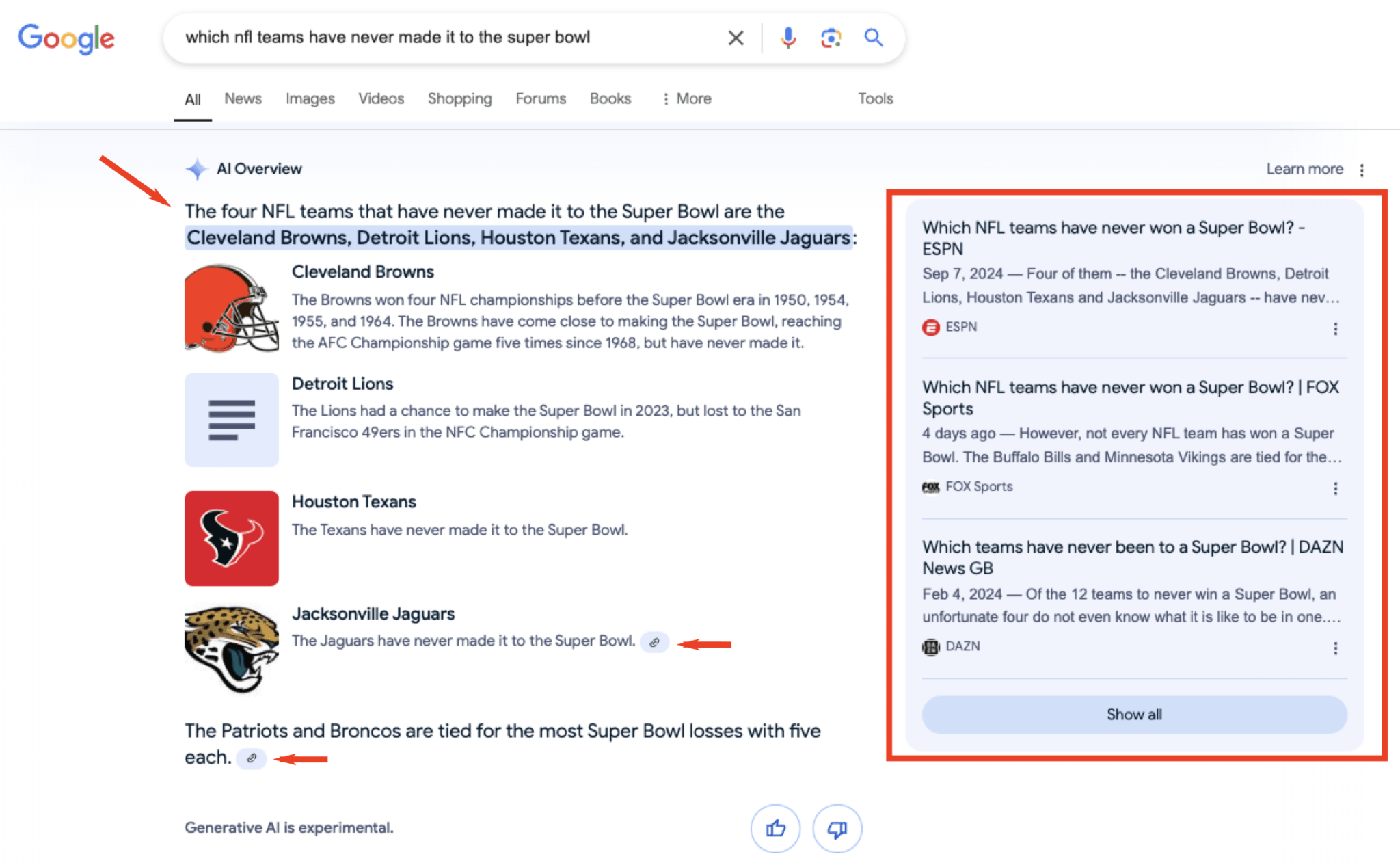
Google AI Overviews are AI-generated summaries that appear above or alongside traditional search results. They aim to answer user queries instantly, citing a few select sources for further reading.
What affects visibility in Google AI Overviews?
- LLMs like PaLM2, Gemini, and MUM
- Google’s core ranking systems (PageRank, Helpful Content, Spam detection, etc.)
- Search intent matching
- Structured data (schema markup)
- E-E-A-T signals (experience, expertise, authority, trust)
- Databases like Google’s Shopping Graph & Knowledge Graph
- Your Money or Your Life (YMYL) topics, like finance, health, and government-related searches
- Multimedia content (images, videos) that supports clarity and engagement
Bing’s AI-powered summaries
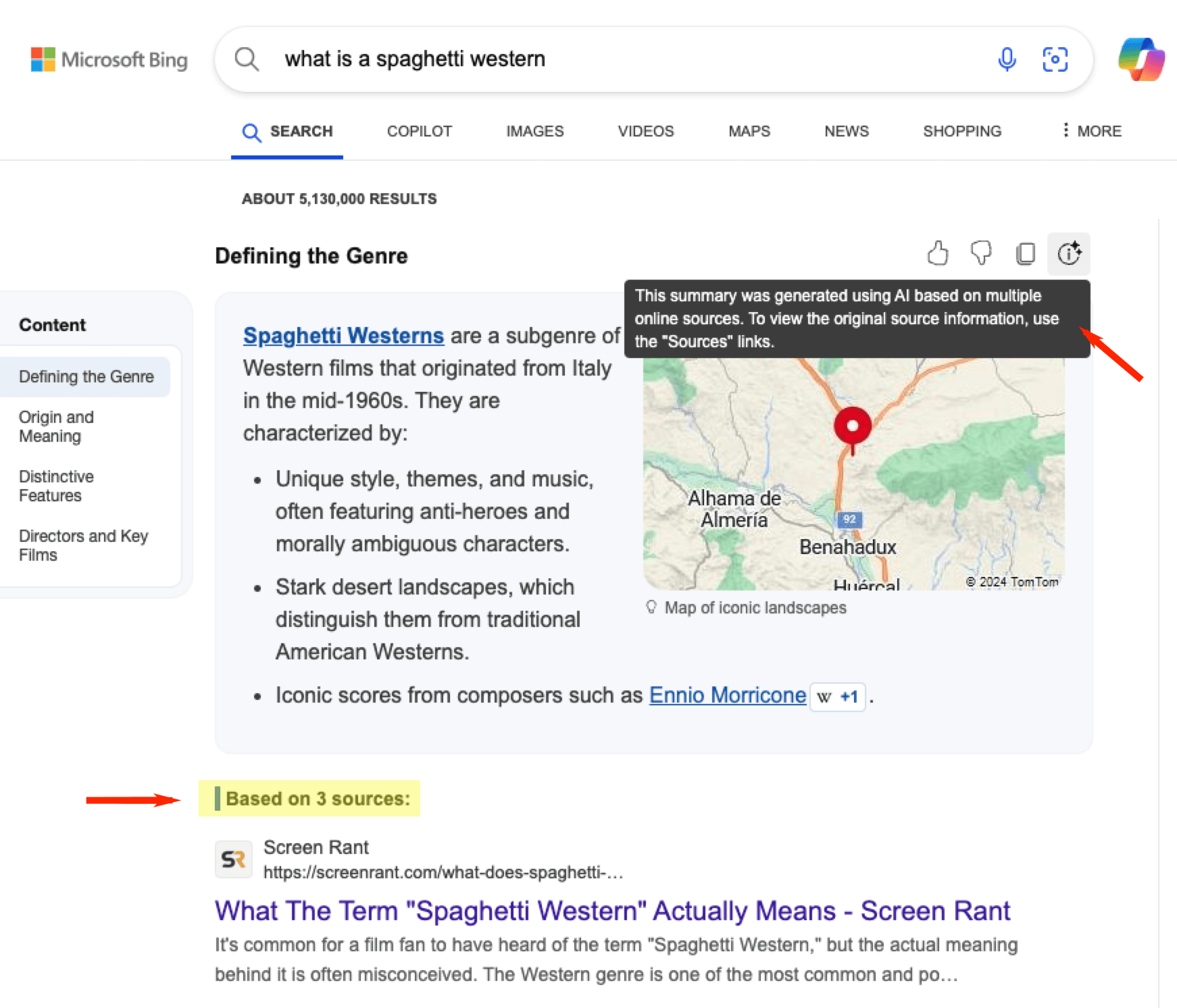
Bing’s AI-powered summaries, part of the broader Bing Generative Search experience (which also includes responses from Copilot in Bing), function similarly to Google’s AI Overviews. They generate conversational, multi-source answers at the top of Bing’s results, referencing web content directly to address user intent.
What factors influence Bing’s AI-powered summaries?
- LLMs such as GPT-4 via Microsoft’s Prometheus model
- Traditional Bing ranking factors (content quality, backlinks, CTR)
- Structured data and semantic relevance
- Site authority and user experience
- Page formatting that supports summarization
Quick comparison table: Google’s AI Overviews vs. Bing’s AI-powered summaries
| Feature | Google AI Overviews | Bing’s AI-powered summaries |
| Based on traditional rankings? | ✅ Yes | ✅ Yes |
| Uses LLMs? | ✅ PaLM2, Gemini, MUM | ✅ GPT-4 via Prometheus |
| Cites external sources? | ✅ Frequently | ✅ Frequently |
| Optimized with schema markup? | ✅ Strongly recommended | ✅ Strongly recommended |
| Prioritizes high-ranking pages? | ✅ Yes | ✅ Yes |
| Includes multimedia in the summary? | ✅ Often | ✅ Occasionally |
Both Google AI Overviews and Bing’s AI-powered summaries are reshaping search behavior. Users now get full answers (and brand recommendations) without ever visiting a website. If your content doesn’t meet the criteria above, you won’t just miss clicks — you’ll miss being seen at all.
How to rank in AI results on search engines
Now that we understand how AI results on search engines work, let’s talk about getting them to notice you. Here are four tips for how to improve visibility in Google and Bing AI search results:
- Clearly answer search intent
- Optimize for E-E-A-T signals
- Target long-tail keywords
- Follow SEO best practices
1. Clearly answer search intent
AI-generated summaries in search results are designed to help users find the answers they need instantly. That said, one of the best ways to improve visibility in AI search results is to answer search intent quickly, clearly, and succinctly.
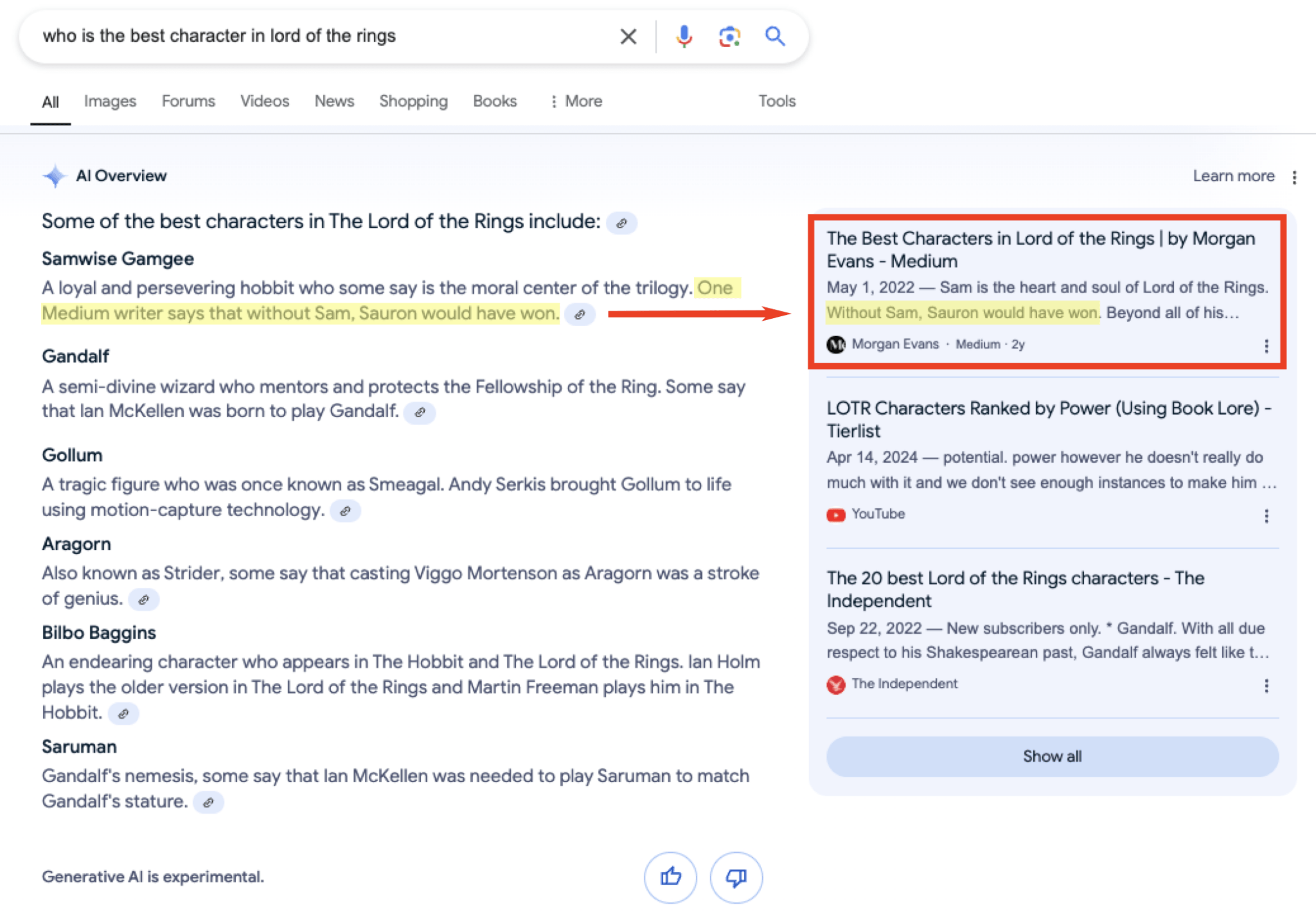
Doing so helps for two key reasons. First, you’re making it easier for AI models to crawl your page and find the information they need to generate a summary. It also increases your chances of being directly quoted in an AI Overview or summary, which can increase your visibility in AI summaries.
2. Optimize for E-E-A-T signals
When pages are trustworthy and helpful, search engines reward them with higher visibility and citations in AI-generated snippets. To make your content more trustworthy, you need to boost your E-E-A-T signals.
E-E-A-T stands for Experience, Expertise, Authority, and Trust. You can boost your E-E-A-T with page optimizations like:
- Including certifications, awards, years of experience, case studies, etc., to demonstrate trust and experience to audiences
- Using an authoritative tone in content
- Supporting claims and statements with quotes from trusted sources like thought leaders, studies, or timely statistics
Recent studies on generative AI and LLMs in search engines have found that enhancing E-E-A-T signals can significantly improve visibility in AI results and overall SEO rankings.
3. Target long-tail keywords
Long-tail keywords are an underrated tool in SEO that helps you rank for more detailed search queries. Long-tail keywords resemble conversational language, and, more importantly, they reflect how people pose in-depth queries to search engines.
AI-powered overviews are meant to help break down those detailed queries, so by targeting long-tail keywords in your content, you can increase your visibility in AI results because you’re better matching the verbiage and cadence of queries that generate AI summaries.
4. Follow SEO best practices
Finally, your best chance at improving your visibility in AI search results is to ensure you’re following SEO best practices. After all, both Google and Bing use search engine ranking factors when generating AI summaries.
For best results, follow Google’s core ranking systems to ensure you’re creating and optimizing your content to perform well on search engines and stand out to LLMs generating AI results. To start, optimize your site for systems like:
How to appear in AI answer engines & chatbots
Answer engine optimization (AEO) is your all-encompassing solution to increasing your visibility on AI platforms like Meta AI, ChatGPT, Gemini, Copilot, Perplexity, and more. AEO involves optimizing your site content to appear in AI-generated responses to user queries. Much like SEO, AEO includes a variety of optimization tactics. Here are some of those tactics:
- Improve your site’s crawlability
- Build your authority
- Ensure your content is relevant
- Generate recommendations and reviews
- Keep content fresh
1. Improve your site’s crawlability
When you’re trying to rank on ChatGPT, crawlability is key. Crawlability refers to how easily web crawlers, also known as spiders, can comb through your site to understand and index it. In other words, it’s how search engines inventory millions of pages on the Internet.
The more crawlable and indexable your site is, the better your chances of ranking higher on search engine results pages (SERPs). In turn, higher rankings can potentially give you increased visibility in AI platforms and chatbots.
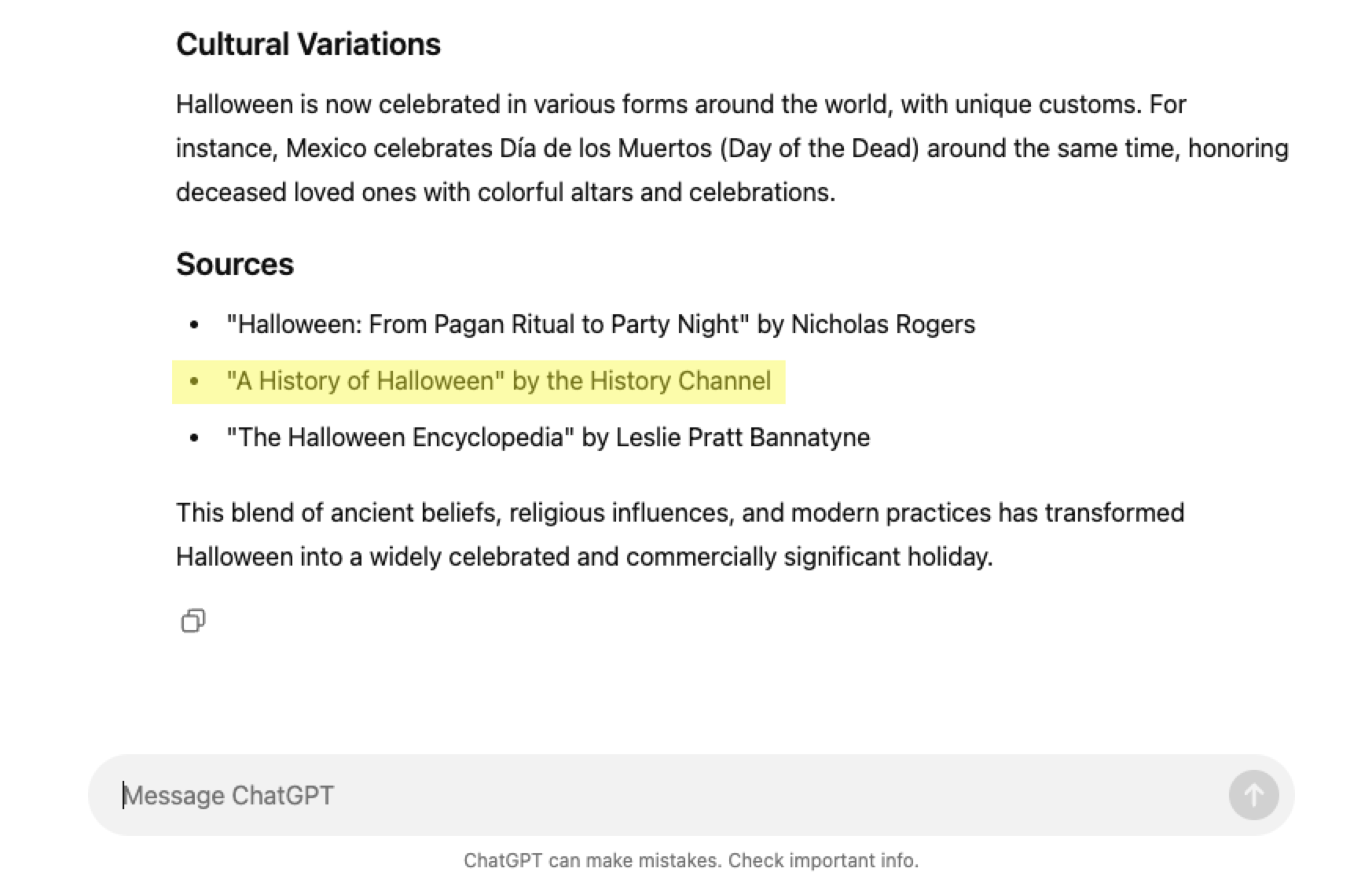
To ensure your site is crawlable for search engines and can show up in AI results, try these optimization tips:
- Break up your content into clear, understandable sections
- Make your website easy to navigate
- Check your meta tags
- Practice good web design tactics
- Provide value to readers with your content
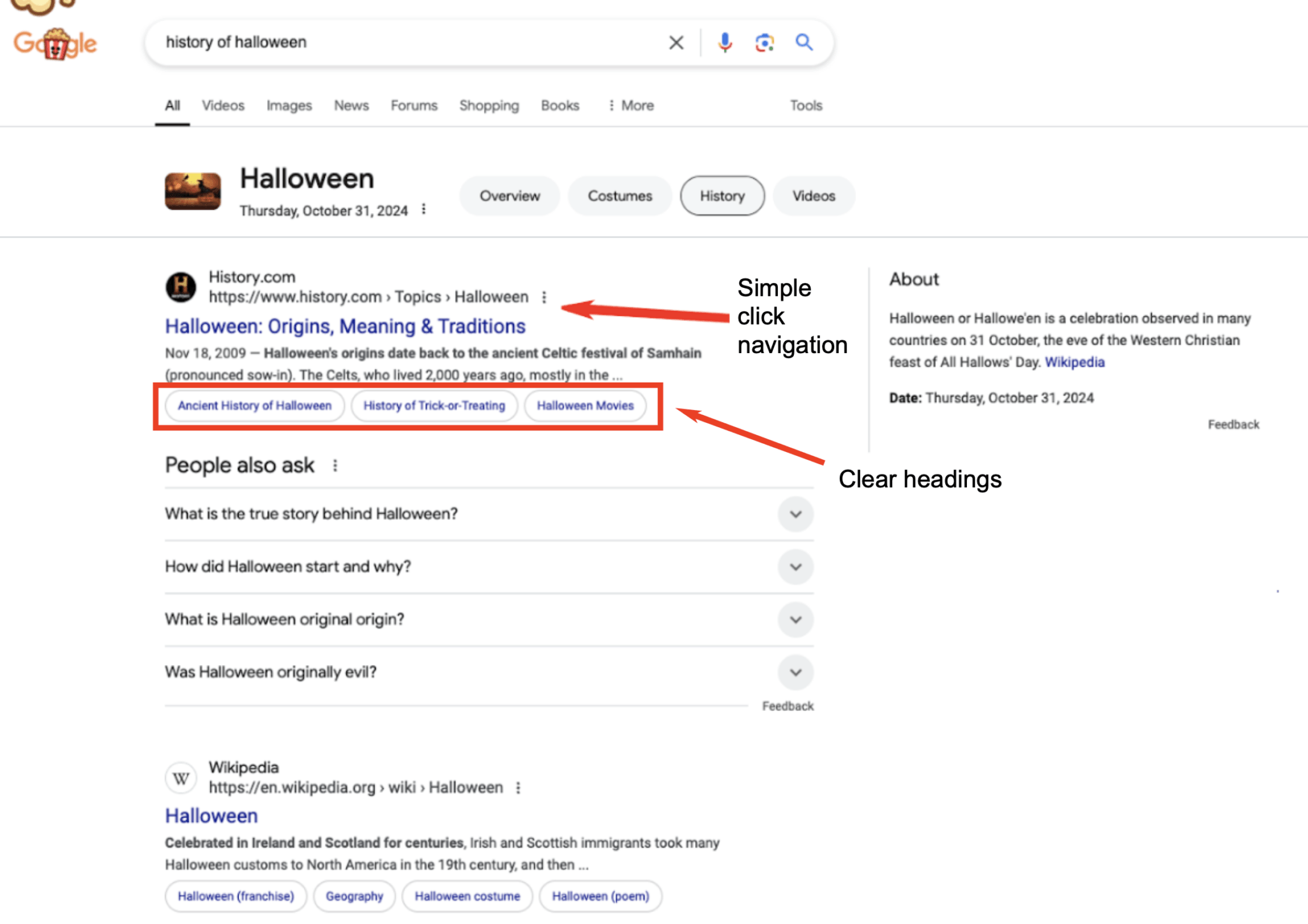
You can learn more about tracking your AI search visibility with our guide on How to Track AI Search Rankings.
2. Build your authority
Authority is crucial when increasing visibility in AI results. Brands and businesses that are recognized as authoritative voices in their industry tend to see higher rankings in AI responses like Copilot because they’re more trustworthy.
Building brand authority means generating awareness around your site, like earning mentions on other authoritative sites.
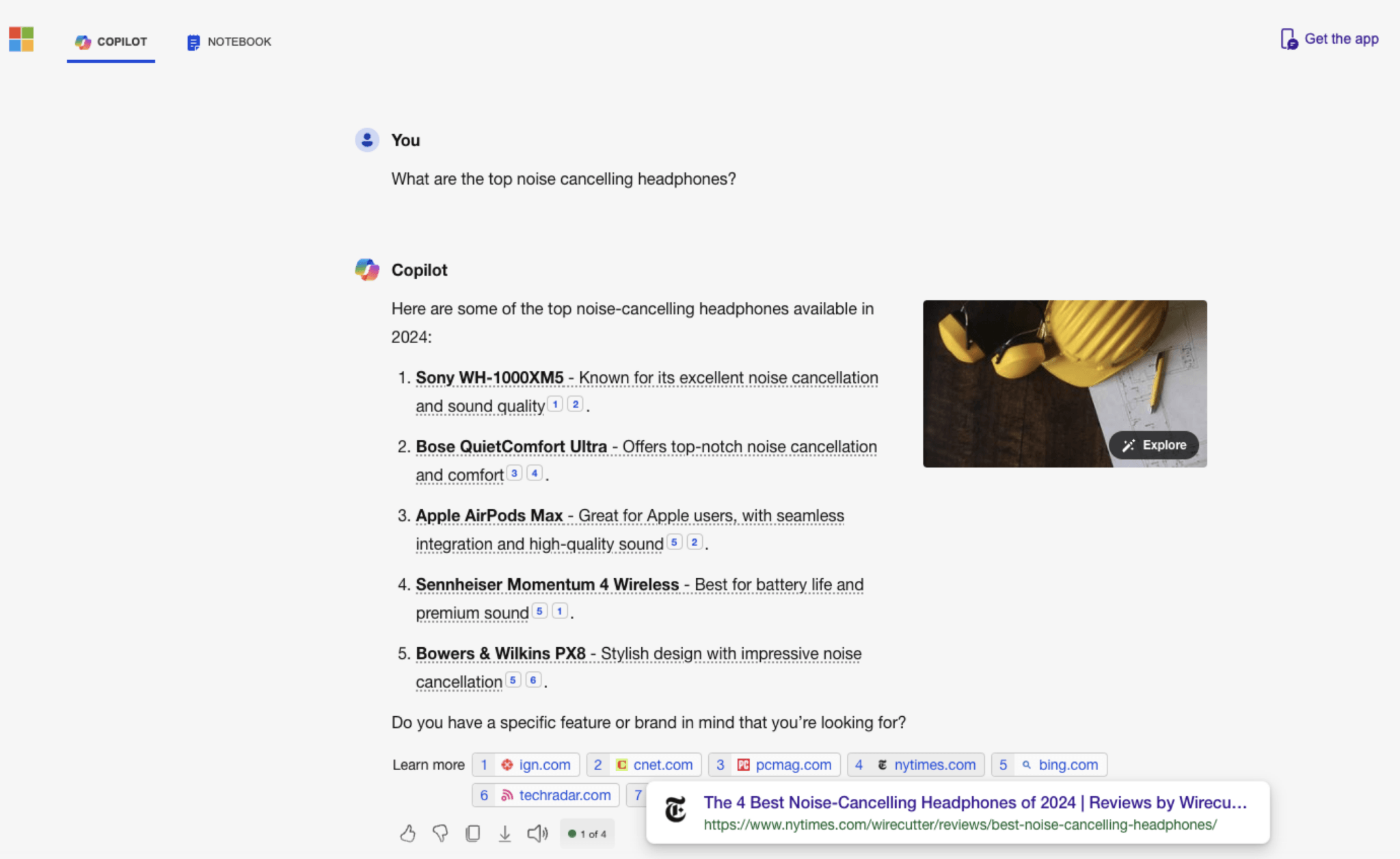
For example, if your product is mentioned in articles that rank similar products, you’re likely to see increased visibility on Copilot, especially if you’re mentioned by authoritative publications like The New York Times.
3. Ensure your content is relevant
AI answer engines and chatbots are built to help people, and that means offering helpful, relevant information when prompted. Ensuring your content is relevant increases your chances of appearing in answers to prompts people use to find information related to your business.
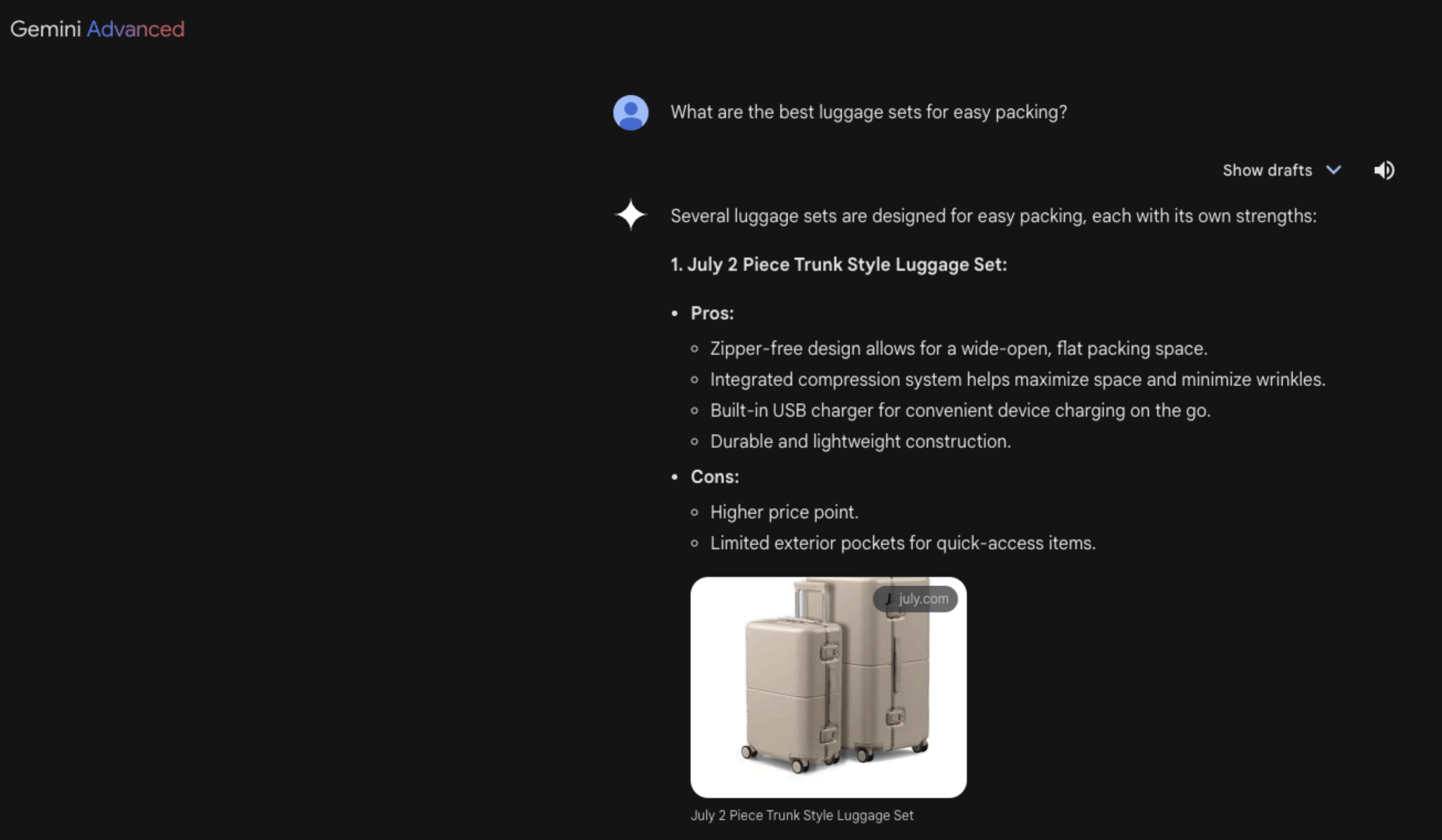
For instance, if you’re a business that sells travel luggage and you want to increase your visibility in Gemini results, you’re going to create content that’s relevant to travel and luggage topics.
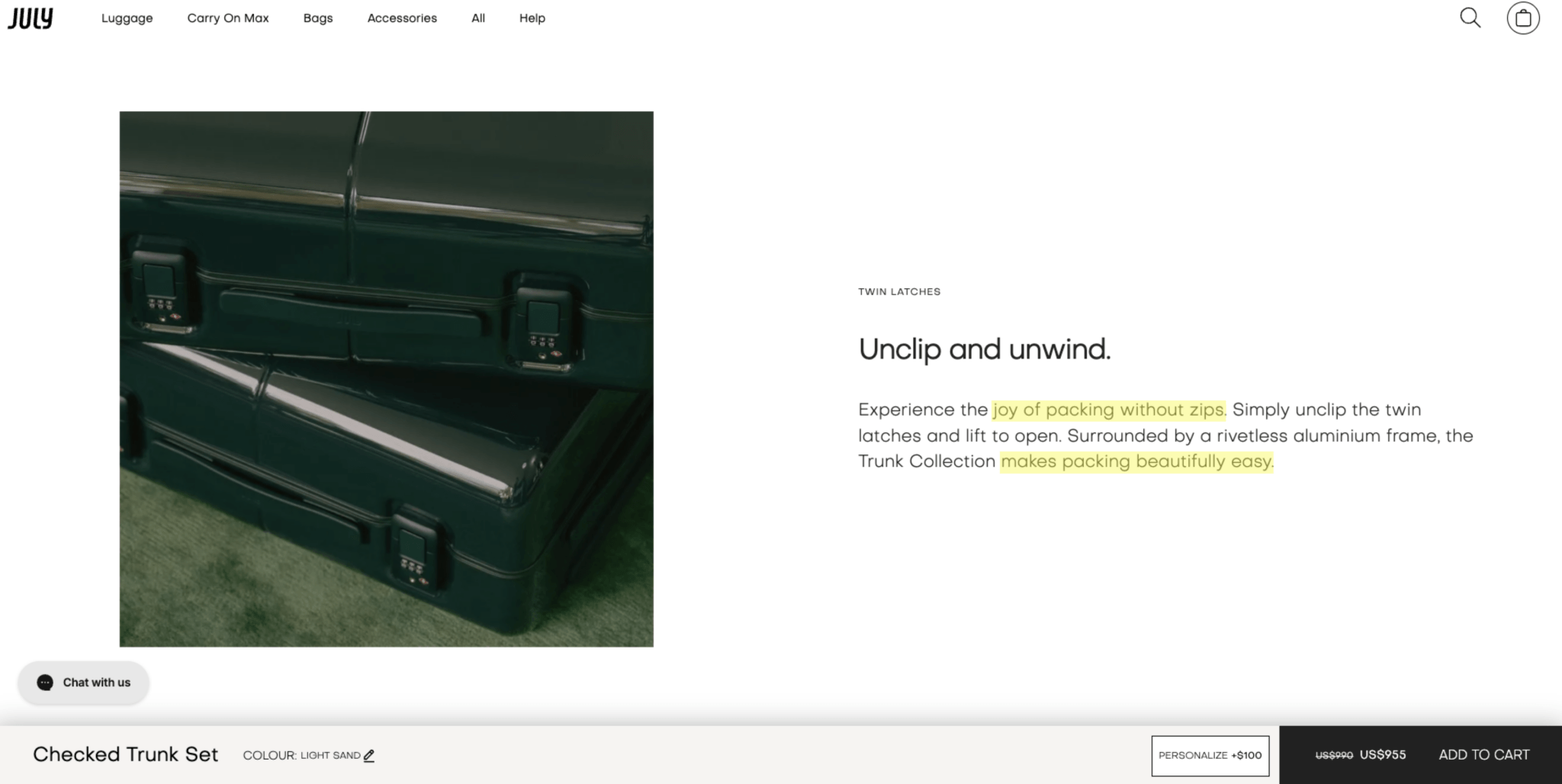
One of Gemini’s top recommendations is a checked trunk set from July. Looking at their product page, it’s easy to see they’ve made themselves highly relevant to the search, targeting keywords related to packing.
4. Generate recommendations and reviews
To improve your AI rankings, you’ll also need to generate reviews and recommendations for your business. For one thing, customer reviews indicate your business is legitimate, making them a key element in people’s decision-making process. AI platforms like Claude see this and, in turn, reward those pages with better visibility in their results.
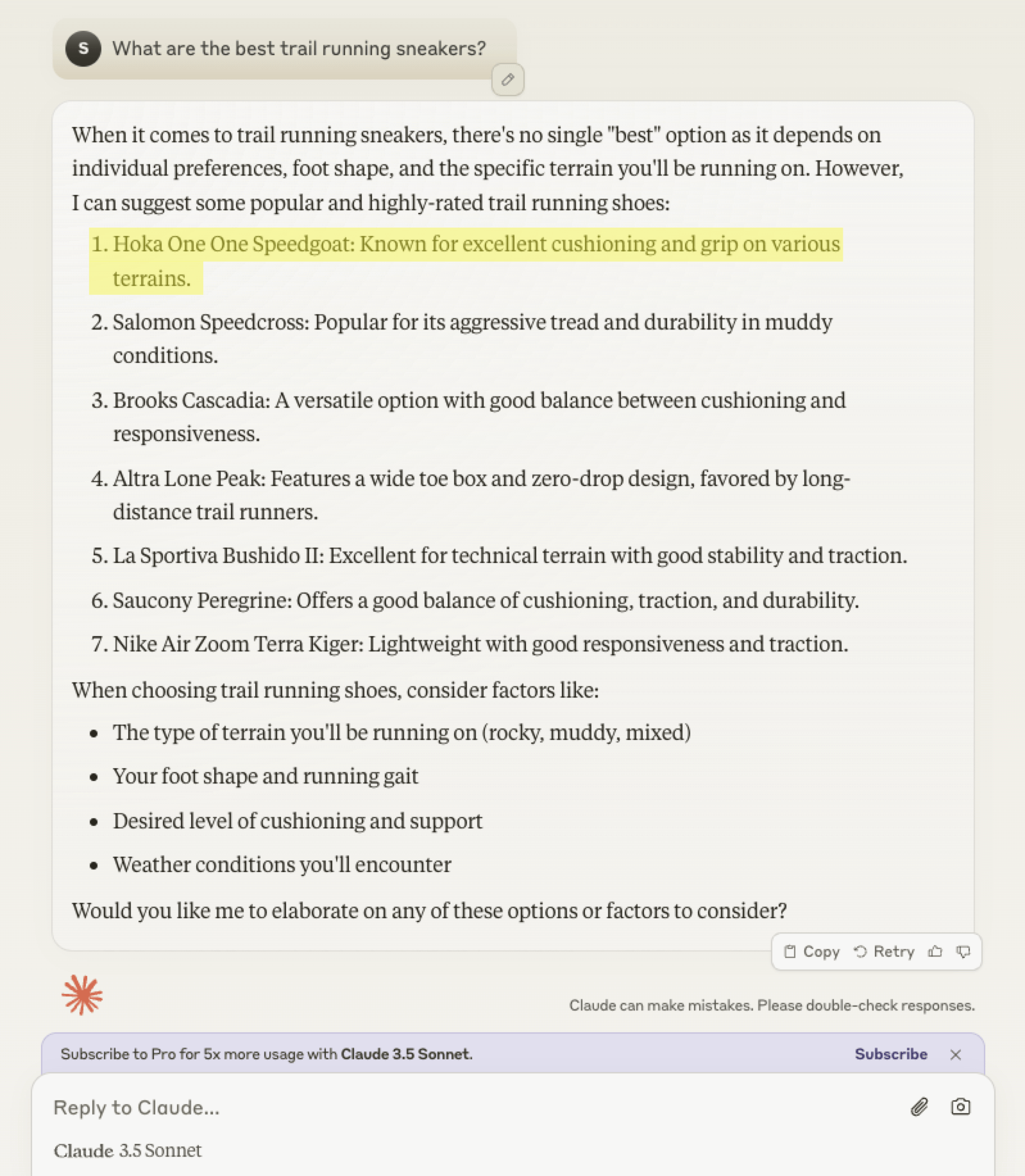
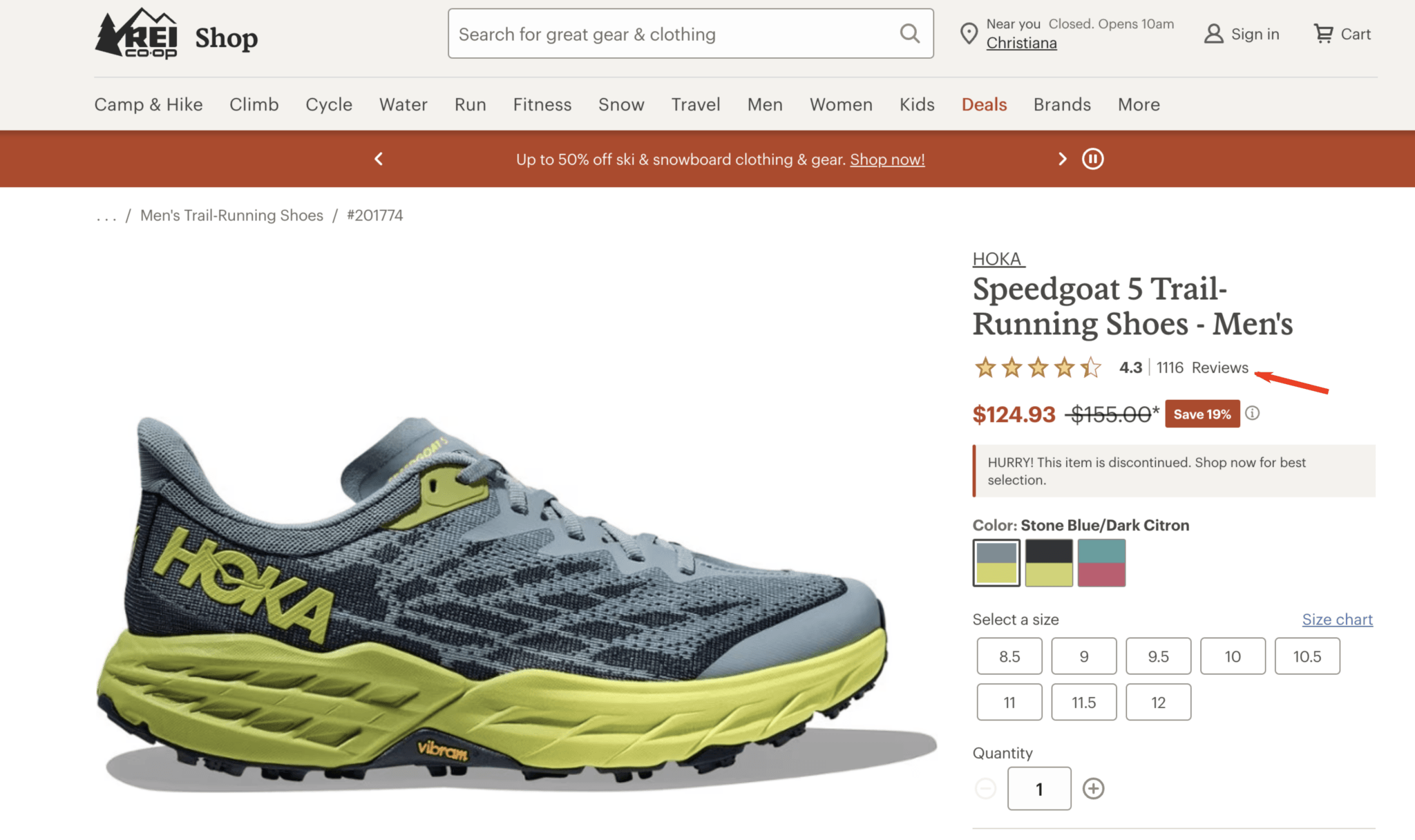
Reviews, recommendations, and customer testimonials on your site (or third-party sites) boost your credibility and demonstrate your authority in your industry. The higher your satisfaction rates, the more you improve visibility in AI results.
5. Keep content fresh
When shopping for produce, you’re not going to buy the old, almost rotten apples, are you? Of course not! Instead, you go for the freshest ones in the bunch. The same logic applies to ranking in AI results.
When generating answers to user queries, AI answer engines prioritize recently published or updated content that includes current information. Outdated information isn’t helpful for anyone, so regularly re-optimizing content ensures it stays fresh and relevant, and increases your visibility on AI platforms.
FAQs on improving visibility in AI results
What is generative engine optimization (GEO)?
Generative engine optimization (GEO) is the process of optimizing content for AI-powered platforms like Google AI Overviews, Bing’s AI-powered summaries, ChatGPT, and Gemini. GEO combines traditional SEO with AI-aligned strategies (like structured data, long-tail keywords, natural language formatting, and E-E-A-T signals) to help your content rank in AI search results and AI-generated responses.
How do I optimize content for AI tools like ChatGPT and Gemini?
To optimize content for AI, use conversational keywords, structured headings, and BLUF formatting. Add schema markup, FAQs, and fresh data to increase your chances of being cited by AI answer engines like Gemini, Copilot, and ChatGPT. Also, improve crawlability for AI bots like ChatGPT-User and PerplexityBot.
How can I improve visibility in AI search results?
To improve visibility in AI search results like Google AI Overviews and Bing’s AI-powered summaries, use generative engine optimization (GEO). GEO focuses on enhancing content clarity, adding schema markup, building E-E-A-T, and ranking organically, since over 50% of AI Overviews cite the top 10 search results.
What’s the difference between AI search and AI answer engines?
AI search refers to features like Google AI Overviews and Bing’s AI-powered summaries that surface instant, multi-source answers directly within traditional search engine results. In contrast, AI answer engines (like ChatGPT, Gemini, or Perplexity) are standalone tools that deliver conversational responses using large language models (LLMs) and, in some cases, real-time data. GEO helps you optimize for both environments.
Do I still need traditional SEO if I want to rank in AI results?
Yes — traditional SEO is the foundation of AI SEO. AI search results like Google AI Overviews and Bing’s AI-powered summaries still rely on search engine ranking systems to identify credible sources. Ranking in organic results increases your chances of being cited in AI-generated summaries.
Why is my brand not appearing in AI answers?
If your brand isn’t showing up in AI answer engines or AI search summaries, it may be due to weak E-E-A-T signals, poor crawlability, outdated content, limited off-site mentions, or lack of semantic relevance. Strengthening your AI SEO strategy and applying GEO tactics can help improve brand visibility.
What keywords should I target for AI SEO?
Target long-tail, question-based keywords that match how users interact with AI tools. These include phrases like:
- “Best [product] for [use case]”
- “How to [achieve goal]”
- “Is [brand] legit?”
- “What’s the difference between [Product A] and [Product B]?”
- “Top-rated [service] near me”
- “Can [brand] help with [problem]?”
These terms reflect natural language queries in AI chatbots and voice search, helping improve your AI search optimization.
Don’t just show up — show out in AI search
AI isn’t a threat to your traffic — it’s your next opportunity. As features and platforms like Google AI Overviews, Bing’s AI-powered summaries, ChatGPT, Copilot, and Gemini continue shaping how users discover content, the brands that adapt now will lead tomorrow’s search.
Understanding where you stand today is crucial, which is why AI brand visibility audit services have become essential for forward-thinking companies.
Need help getting started? At WebFX, we bring over 25+ years of digital expertise and a future-forward AI SEO strategy to keep your content competitive — no matter how search evolves.
With our high-impact GEO services, you’ll get:
- A tailored roadmap to boost visibility in AI search results
- Expert optimization for both search engines and LLMs
- A dedicated account manager and access to RevenueCloudFX
- Real-time performance tracking and AI search monitoring
AI is redefining the front page of the Internet — let’s make sure it can’t ignore yours. Contact us online or call 888-601-5359 to speak with a strategist today about our industry-leading GEO services.
-
 Savannah is a content marketer with editorial experience spanning several businesses. Specializing in social media and marketing trends, she loves talking about the latest developments in online marketing. When she’s not writing, Savannah loves traveling, hoarding books and coffee mugs, and adoring her cat. Please don’t ask her about famous true crime cases, or else she’ll tell you all about her theories and get absolutely no work done.
Savannah is a content marketer with editorial experience spanning several businesses. Specializing in social media and marketing trends, she loves talking about the latest developments in online marketing. When she’s not writing, Savannah loves traveling, hoarding books and coffee mugs, and adoring her cat. Please don’t ask her about famous true crime cases, or else she’ll tell you all about her theories and get absolutely no work done. -

WebFX is a full-service marketing agency with 1,100+ client reviews and a 4.9-star rating on Clutch! Find out how our expert team and revenue-accelerating tech can drive results for you! Learn more
Try our free Marketing Calculator
Craft a tailored online marketing strategy! Utilize our free Internet marketing calculator for a custom plan based on your location, reach, timeframe, and budget.
Plan Your Marketing Budget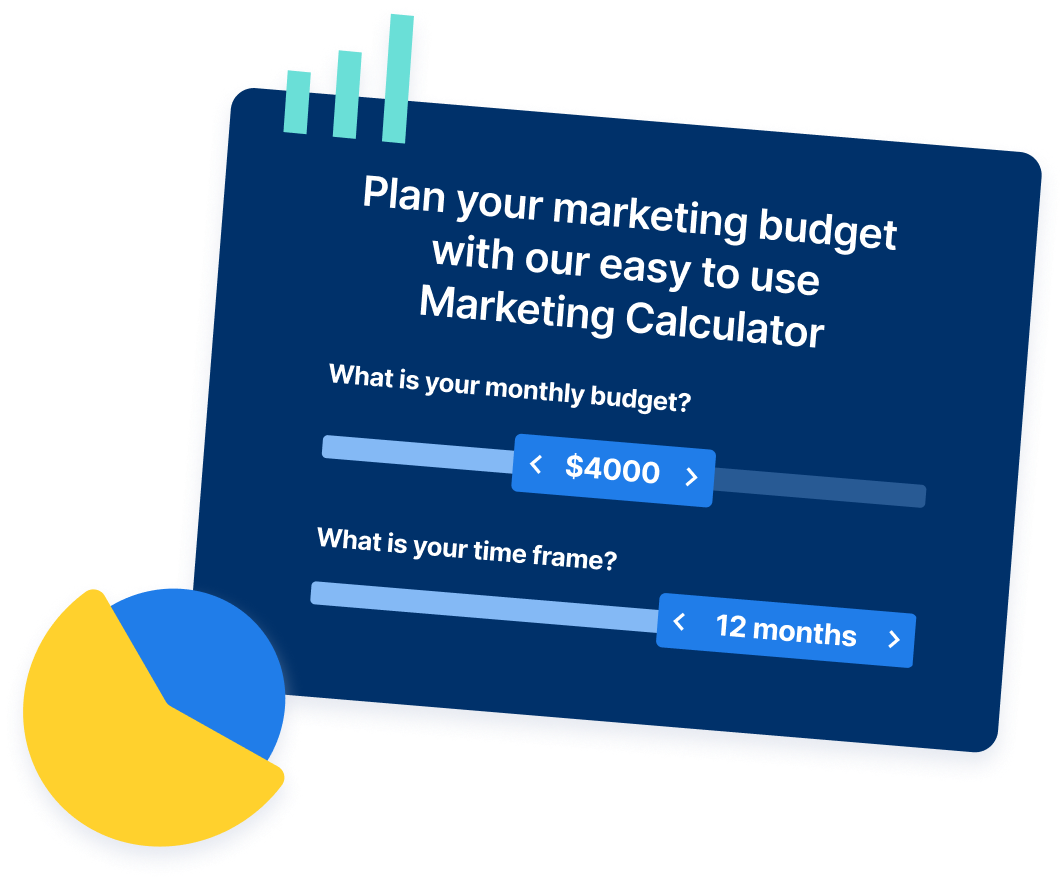
Table of Contents
- What is generative engine optimization (GEO)?
- The AI visibility ladder: Your GEO framework
- Step 1: Foundation (traditional SEO)
- Step 2: Relevance (align with AI search context)
- Step 3: Trust (strengthen E-E-A-T signals)
- Step 4: Influence (earn mentions and external signals)
- How AI search results work (and why visibility has changed)
- Google AI Overviews
- Bing’s AI-powered summaries
- Quick comparison table: Google’s AI Overviews vs. Bing’s AI-powered summaries
- How to rank in AI results on search engines
- 1. Clearly answer search intent
- 2. Optimize for E-E-A-T signals
- 3. Target long-tail keywords
- 4. Follow SEO best practices
- How to appear in AI answer engines & chatbots
- 1. Improve your site’s crawlability
- 2. Build your authority
- 3. Ensure your content is relevant
- 4. Generate recommendations and reviews
- 5. Keep content fresh
- FAQs on improving visibility in AI results
- Don’t just show up — show out in AI search

SEO Success with KOA

Proven Marketing Strategies
Try our free Marketing Calculator
Craft a tailored online marketing strategy! Utilize our free Internet marketing calculator for a custom plan based on your location, reach, timeframe, and budget.
Plan Your Marketing Budget
What to read next




